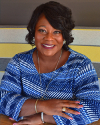
A Message from Ujima Donalson
Assistant Vice President, Total Talent Management
As a leader, woman, and person of color, I am often asked to participate in diversity activities—diversity committees, diversity roundtables, diversity panels, and so forth. I appreciate the diversity and inclusion work being done at the University, and yet I do sometimes wonder if there are other not so obvious choices that should be included in this work. It seems the assumption is made that we don’t have adequate bench strength, so the same people get tapped to participate across groups.
The truth is we do have an increasingly diverse population here at the UW. We might just have to look past our initial perceptions and think more deeply or broadly about the possible intersectionalities and interests of people on our team. Also, we should recognize that—thanks in no small part to the Race and Equity Initiative and Diversity Blueprint—more people are advancing their awareness and cultural competency, rolling up their sleeves, and working to be part of the solution. That said, there are still many who are interested in improving diversity, equity, and inclusion but are held back by uncertainty, inexperience, or even fear about how to engage in this work.
It is true that sometime the hardest part is just getting started. I encourage you to spend some time with this issue of The Leading Edge to gain concrete ideas, practical solutions, and heightened inspiration to forge a more inclusive and equitable environment here at the UW. I believe the articles help to demystify efforts around diversity and inclusion, and I am quite pleased to share these contributors’ experiences and perspectives with you.
Along with uncertainty, inexperience, and fear, another barrier to diversity and inclusion work is just plain resistance. Some people may believe that governance around equal opportunity is limiting — that being encouraged or required to be inclusive may limit what we want or hope to happen, from who we want to hire to who we want to collaborate with on a project. The truth is that equal opportunity expands opportunity not just for historically excluded or protected groups but for all. There is a richness in perspective when we diversify that cannot be replicated by a group of people with similar backgrounds and experiences.
According to a recent NPR story heard on our own KUOW, “a growing body of scientific research suggests one way to improve creative output is to form deep connections with people from other countries and different cultures.” Exposure to other cultures heightens our creativity and also, in turn, our problem-solving abilities.
Another way to think of this is the “edge effect,” which biologist Eugene Odum described as “the tendency for increased variety and diversity at community junctions” or at the boundary of two or more habitat types. Yo-Yo Ma has cited the edge effect in reference to his Silk Road Ensemble, a collective that thrives on multicultural artistic exchanges. If it is believed that newness is formed on the edges of ourselves or at these community junctions, I’d like to invite you into that space and wish you creative innovation as well as a renewed outlook on life and what’s possible in your workplace.


